Tender Bid Report: AAA Construction Company's Bid Analysis
VerifiedAdded on 2021/04/21
|13
|4252
|440
Report
AI Summary
This tender bid report provides a comprehensive analysis of a construction project bid, focusing on the Al Batinah Expressway in Oman. The report, prepared by a student, examines the procurement strategy, bidding strategy, and cost analysis undertaken by AAA Construction Company. It details the project's background, objectives, and the company's approach to the tender, including considerations for sustainability, safety, and environmental impact. The report also includes a literature review of tendering processes, procurement strategies, and bidding techniques, offering valuable insights into the construction industry's practices. The report's core revolves around the construction of the Al Batinah Expressway, specifically package 4, and highlights factors considered during the project's design and execution. This report is a valuable resource for students studying construction management, business development, and related fields, providing a real-world case study of the tendering process and its complexities. The report also discusses various procurement strategies and bidding strategies employed to increase the chances of winning the bid.
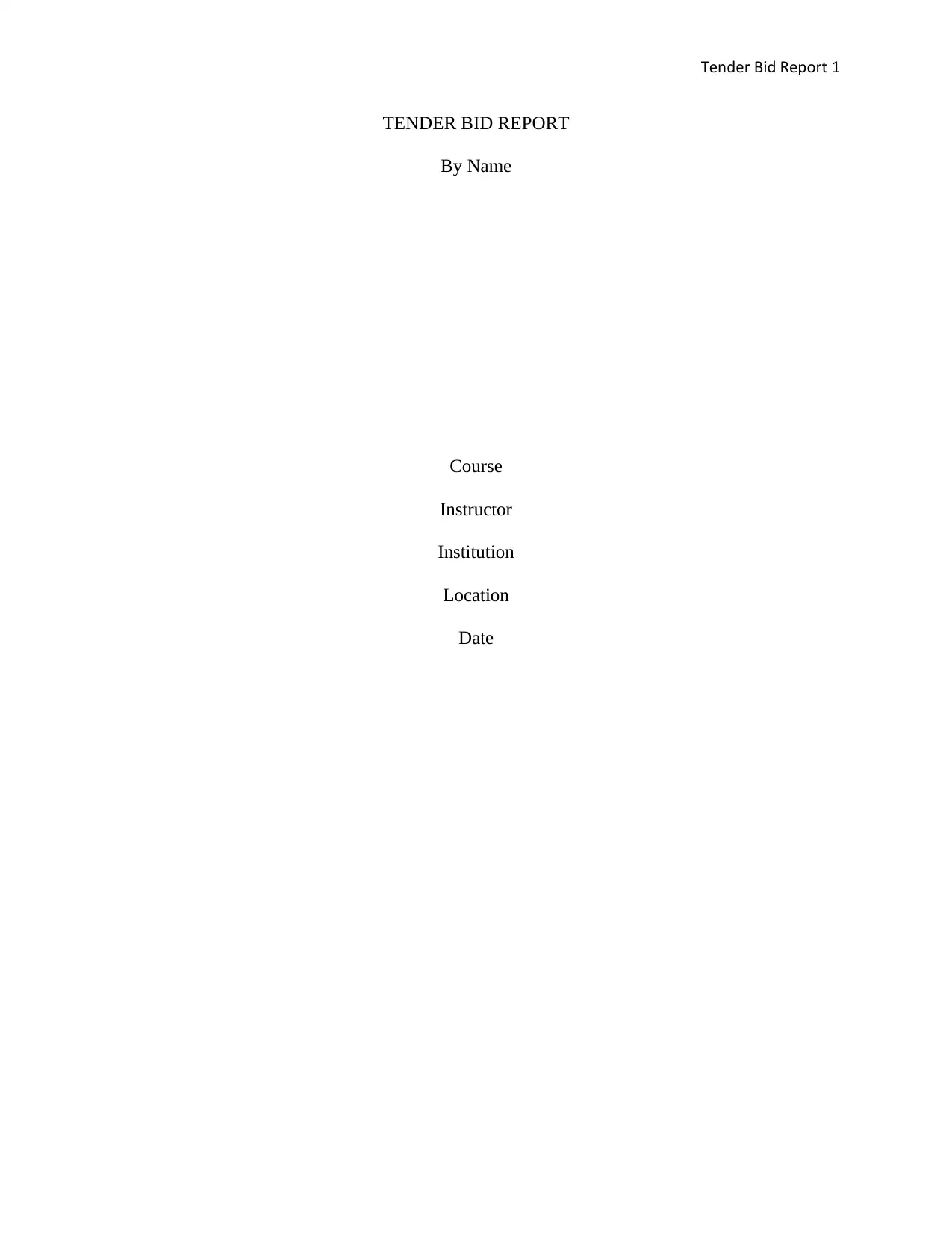
Tender Bid Report 1
TENDER BID REPORT
By Name
Course
Instructor
Institution
Location
Date
TENDER BID REPORT
By Name
Course
Instructor
Institution
Location
Date
Paraphrase This Document
Need a fresh take? Get an instant paraphrase of this document with our AI Paraphraser
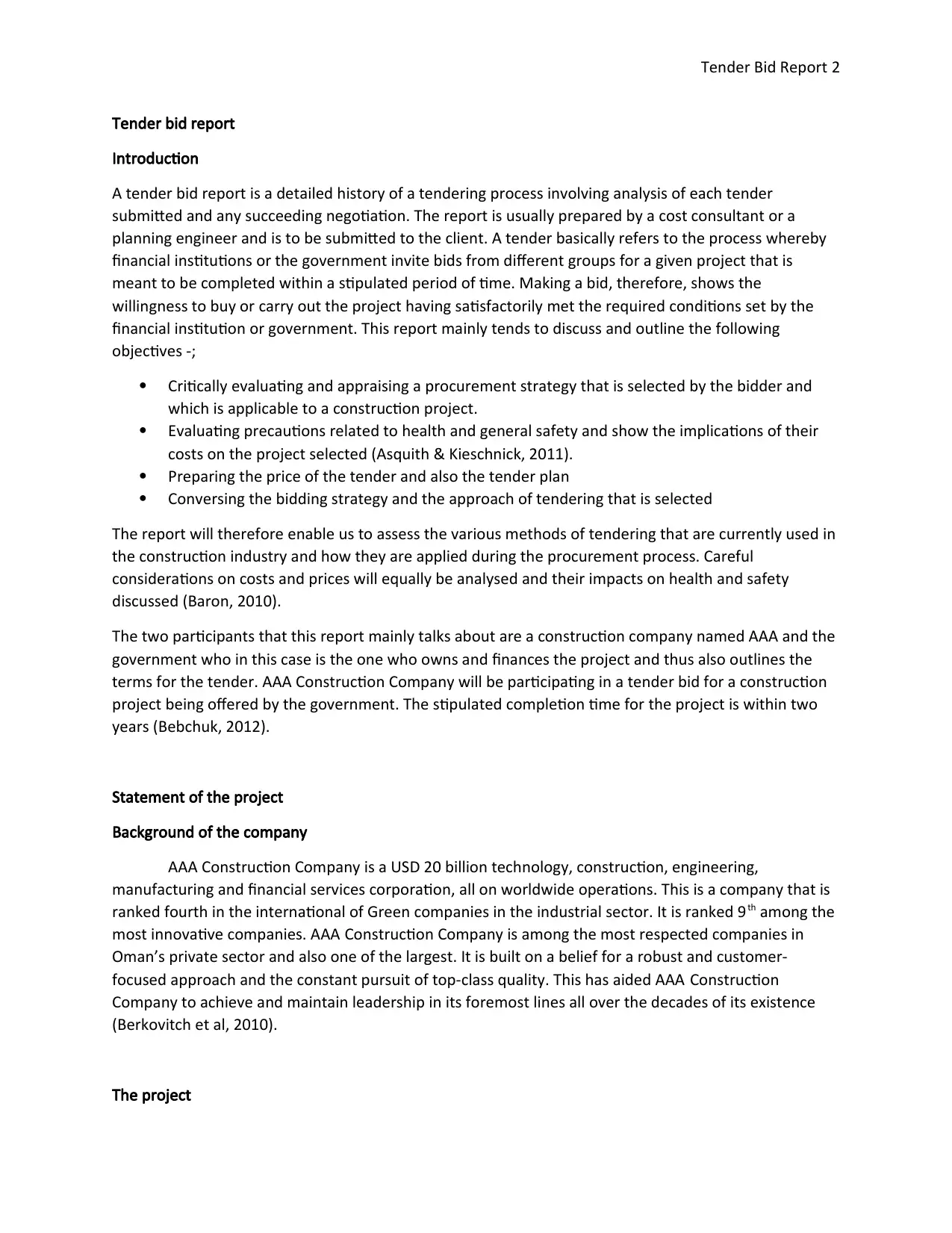
Tender Bid Report 2
Tender bid report
Introduction
A tender bid report is a detailed history of a tendering process involving analysis of each tender
submitted and any succeeding negotiation. The report is usually prepared by a cost consultant or a
planning engineer and is to be submitted to the client. A tender basically refers to the process whereby
financial institutions or the government invite bids from different groups for a given project that is
meant to be completed within a stipulated period of time. Making a bid, therefore, shows the
willingness to buy or carry out the project having satisfactorily met the required conditions set by the
financial institution or government. This report mainly tends to discuss and outline the following
objectives -;
Critically evaluating and appraising a procurement strategy that is selected by the bidder and
which is applicable to a construction project.
Evaluating precautions related to health and general safety and show the implications of their
costs on the project selected (Asquith & Kieschnick, 2011).
Preparing the price of the tender and also the tender plan
Conversing the bidding strategy and the approach of tendering that is selected
The report will therefore enable us to assess the various methods of tendering that are currently used in
the construction industry and how they are applied during the procurement process. Careful
considerations on costs and prices will equally be analysed and their impacts on health and safety
discussed (Baron, 2010).
The two participants that this report mainly talks about are a construction company named AAA and the
government who in this case is the one who owns and finances the project and thus also outlines the
terms for the tender. AAA Construction Company will be participating in a tender bid for a construction
project being offered by the government. The stipulated completion time for the project is within two
years (Bebchuk, 2012).
Statement of the project
Background of the company
AAA Construction Company is a USD 20 billion technology, construction, engineering,
manufacturing and financial services corporation, all on worldwide operations. This is a company that is
ranked fourth in the international of Green companies in the industrial sector. It is ranked 9th among the
most innovative companies. AAA Construction Company is among the most respected companies in
Oman’s private sector and also one of the largest. It is built on a belief for a robust and customer-
focused approach and the constant pursuit of top-class quality. This has aided AAA Construction
Company to achieve and maintain leadership in its foremost lines all over the decades of its existence
(Berkovitch et al, 2010).
The project
Tender bid report
Introduction
A tender bid report is a detailed history of a tendering process involving analysis of each tender
submitted and any succeeding negotiation. The report is usually prepared by a cost consultant or a
planning engineer and is to be submitted to the client. A tender basically refers to the process whereby
financial institutions or the government invite bids from different groups for a given project that is
meant to be completed within a stipulated period of time. Making a bid, therefore, shows the
willingness to buy or carry out the project having satisfactorily met the required conditions set by the
financial institution or government. This report mainly tends to discuss and outline the following
objectives -;
Critically evaluating and appraising a procurement strategy that is selected by the bidder and
which is applicable to a construction project.
Evaluating precautions related to health and general safety and show the implications of their
costs on the project selected (Asquith & Kieschnick, 2011).
Preparing the price of the tender and also the tender plan
Conversing the bidding strategy and the approach of tendering that is selected
The report will therefore enable us to assess the various methods of tendering that are currently used in
the construction industry and how they are applied during the procurement process. Careful
considerations on costs and prices will equally be analysed and their impacts on health and safety
discussed (Baron, 2010).
The two participants that this report mainly talks about are a construction company named AAA and the
government who in this case is the one who owns and finances the project and thus also outlines the
terms for the tender. AAA Construction Company will be participating in a tender bid for a construction
project being offered by the government. The stipulated completion time for the project is within two
years (Bebchuk, 2012).
Statement of the project
Background of the company
AAA Construction Company is a USD 20 billion technology, construction, engineering,
manufacturing and financial services corporation, all on worldwide operations. This is a company that is
ranked fourth in the international of Green companies in the industrial sector. It is ranked 9th among the
most innovative companies. AAA Construction Company is among the most respected companies in
Oman’s private sector and also one of the largest. It is built on a belief for a robust and customer-
focused approach and the constant pursuit of top-class quality. This has aided AAA Construction
Company to achieve and maintain leadership in its foremost lines all over the decades of its existence
(Berkovitch et al, 2010).
The project
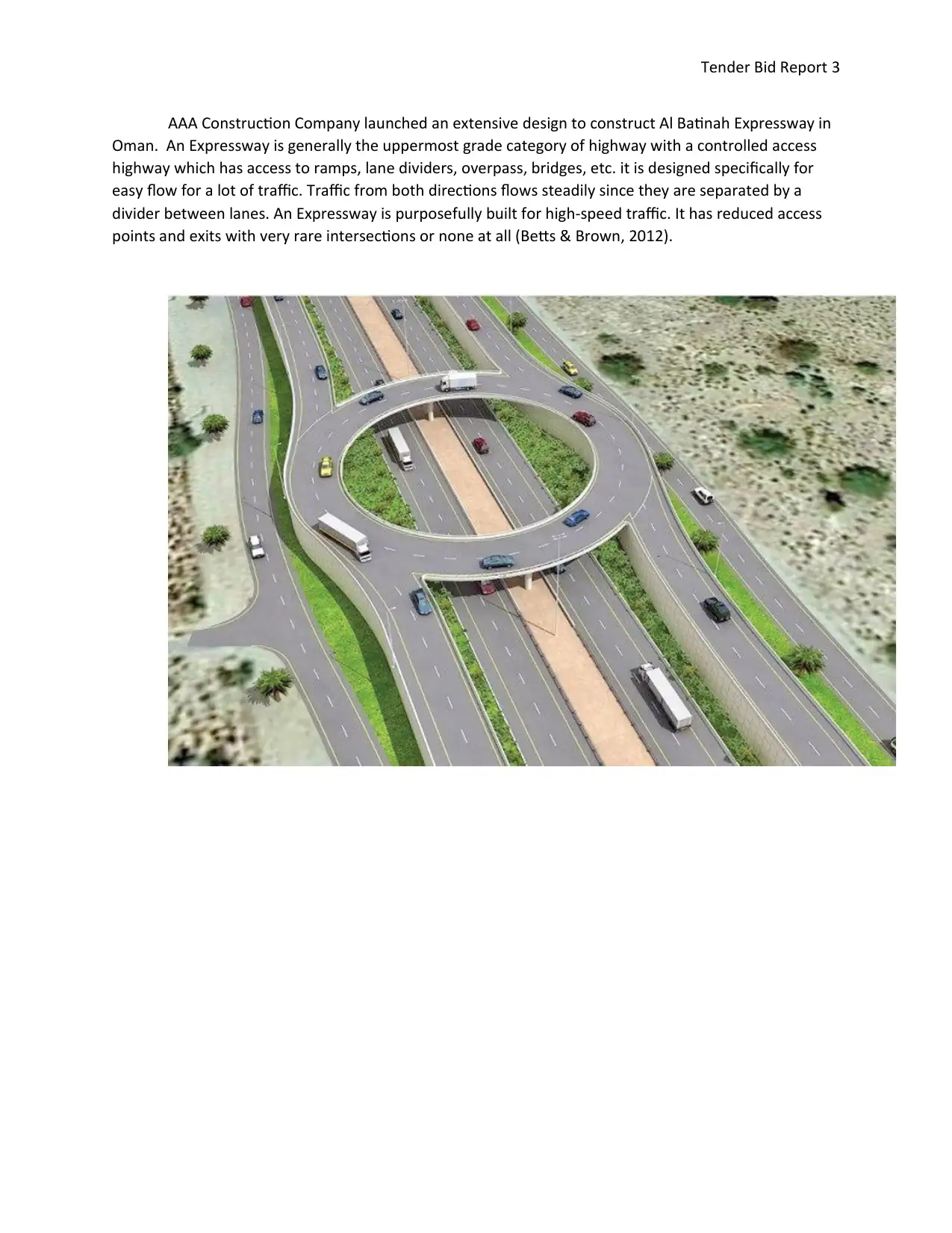
Tender Bid Report 3
AAA Construction Company launched an extensive design to construct Al Batinah Expressway in
Oman. An Expressway is generally the uppermost grade category of highway with a controlled access
highway which has access to ramps, lane dividers, overpass, bridges, etc. it is designed specifically for
easy flow for a lot of traffic. Traffic from both directions flows steadily since they are separated by a
divider between lanes. An Expressway is purposefully built for high-speed traffic. It has reduced access
points and exits with very rare intersections or none at all (Betts & Brown, 2012).
AAA Construction Company launched an extensive design to construct Al Batinah Expressway in
Oman. An Expressway is generally the uppermost grade category of highway with a controlled access
highway which has access to ramps, lane dividers, overpass, bridges, etc. it is designed specifically for
easy flow for a lot of traffic. Traffic from both directions flows steadily since they are separated by a
divider between lanes. An Expressway is purposefully built for high-speed traffic. It has reduced access
points and exits with very rare intersections or none at all (Betts & Brown, 2012).
⊘ This is a preview!⊘
Do you want full access?
Subscribe today to unlock all pages.

Trusted by 1+ million students worldwide
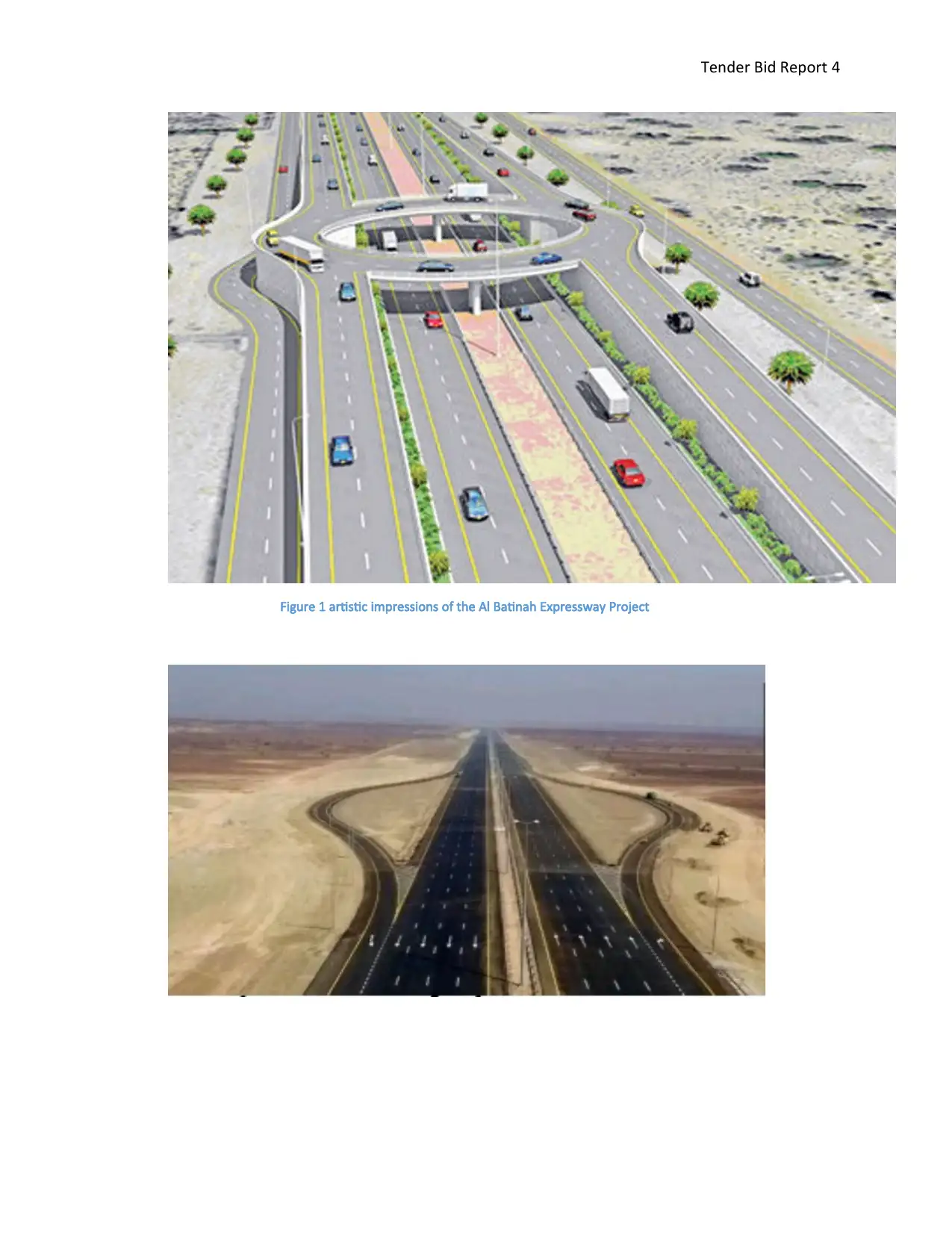
Tender Bid Report 4
Figure 1 artistic impressions of the Al Batinah Expressway Project
Figure 1 artistic impressions of the Al Batinah Expressway Project
Paraphrase This Document
Need a fresh take? Get an instant paraphrase of this document with our AI Paraphraser
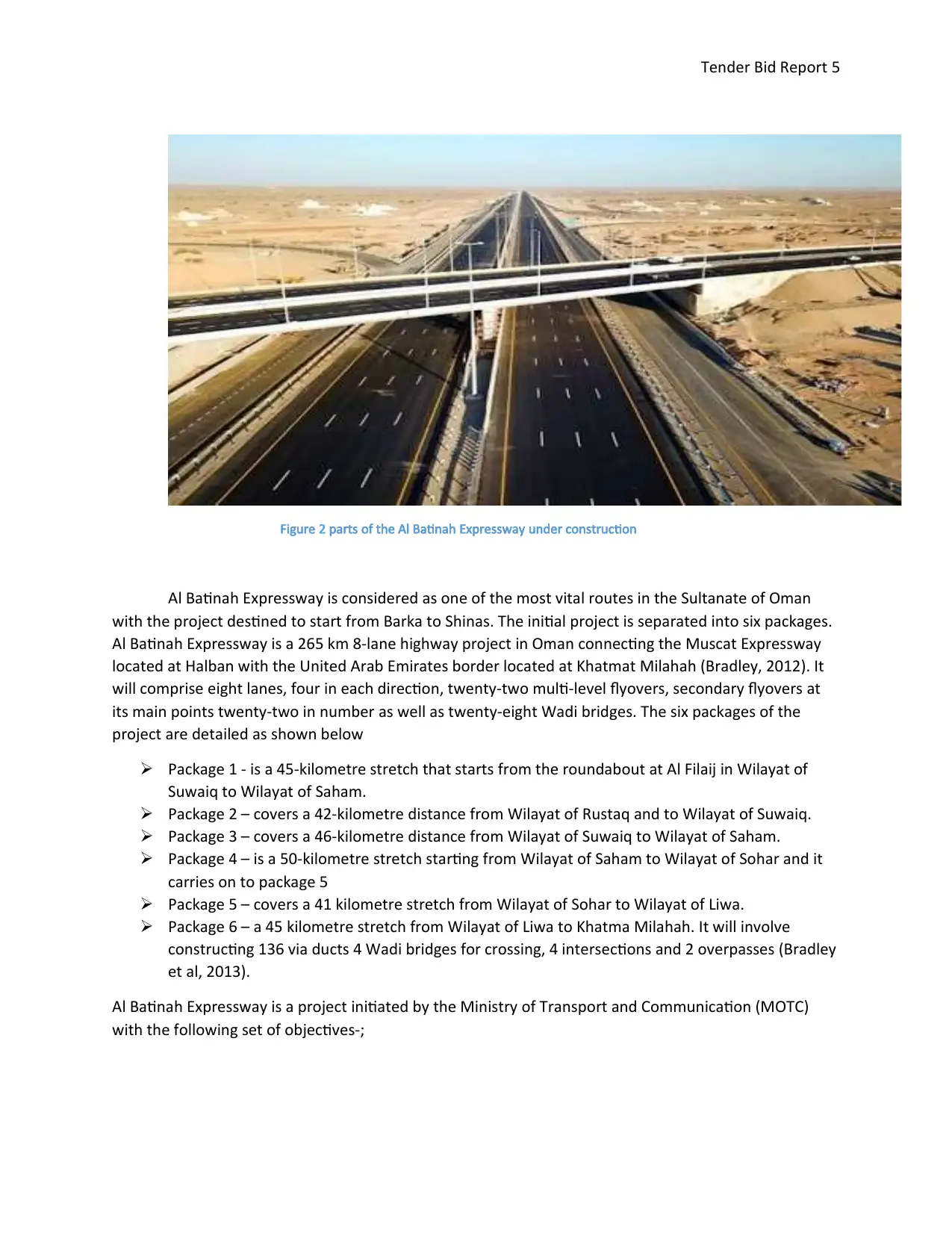
Tender Bid Report 5
Figure 2 parts of the Al Batinah Expressway under construction
Al Batinah Expressway is considered as one of the most vital routes in the Sultanate of Oman
with the project destined to start from Barka to Shinas. The initial project is separated into six packages.
Al Batinah Expressway is a 265 km 8-lane highway project in Oman connecting the Muscat Expressway
located at Halban with the United Arab Emirates border located at Khatmat Milahah (Bradley, 2012). It
will comprise eight lanes, four in each direction, twenty-two multi-level flyovers, secondary flyovers at
its main points twenty-two in number as well as twenty-eight Wadi bridges. The six packages of the
project are detailed as shown below
Package 1 - is a 45-kilometre stretch that starts from the roundabout at Al Filaij in Wilayat of
Suwaiq to Wilayat of Saham.
Package 2 – covers a 42-kilometre distance from Wilayat of Rustaq and to Wilayat of Suwaiq.
Package 3 – covers a 46-kilometre distance from Wilayat of Suwaiq to Wilayat of Saham.
Package 4 – is a 50-kilometre stretch starting from Wilayat of Saham to Wilayat of Sohar and it
carries on to package 5
Package 5 – covers a 41 kilometre stretch from Wilayat of Sohar to Wilayat of Liwa.
Package 6 – a 45 kilometre stretch from Wilayat of Liwa to Khatma Milahah. It will involve
constructing 136 via ducts 4 Wadi bridges for crossing, 4 intersections and 2 overpasses (Bradley
et al, 2013).
Al Batinah Expressway is a project initiated by the Ministry of Transport and Communication (MOTC)
with the following set of objectives-;
Figure 2 parts of the Al Batinah Expressway under construction
Al Batinah Expressway is considered as one of the most vital routes in the Sultanate of Oman
with the project destined to start from Barka to Shinas. The initial project is separated into six packages.
Al Batinah Expressway is a 265 km 8-lane highway project in Oman connecting the Muscat Expressway
located at Halban with the United Arab Emirates border located at Khatmat Milahah (Bradley, 2012). It
will comprise eight lanes, four in each direction, twenty-two multi-level flyovers, secondary flyovers at
its main points twenty-two in number as well as twenty-eight Wadi bridges. The six packages of the
project are detailed as shown below
Package 1 - is a 45-kilometre stretch that starts from the roundabout at Al Filaij in Wilayat of
Suwaiq to Wilayat of Saham.
Package 2 – covers a 42-kilometre distance from Wilayat of Rustaq and to Wilayat of Suwaiq.
Package 3 – covers a 46-kilometre distance from Wilayat of Suwaiq to Wilayat of Saham.
Package 4 – is a 50-kilometre stretch starting from Wilayat of Saham to Wilayat of Sohar and it
carries on to package 5
Package 5 – covers a 41 kilometre stretch from Wilayat of Sohar to Wilayat of Liwa.
Package 6 – a 45 kilometre stretch from Wilayat of Liwa to Khatma Milahah. It will involve
constructing 136 via ducts 4 Wadi bridges for crossing, 4 intersections and 2 overpasses (Bradley
et al, 2013).
Al Batinah Expressway is a project initiated by the Ministry of Transport and Communication (MOTC)
with the following set of objectives-;
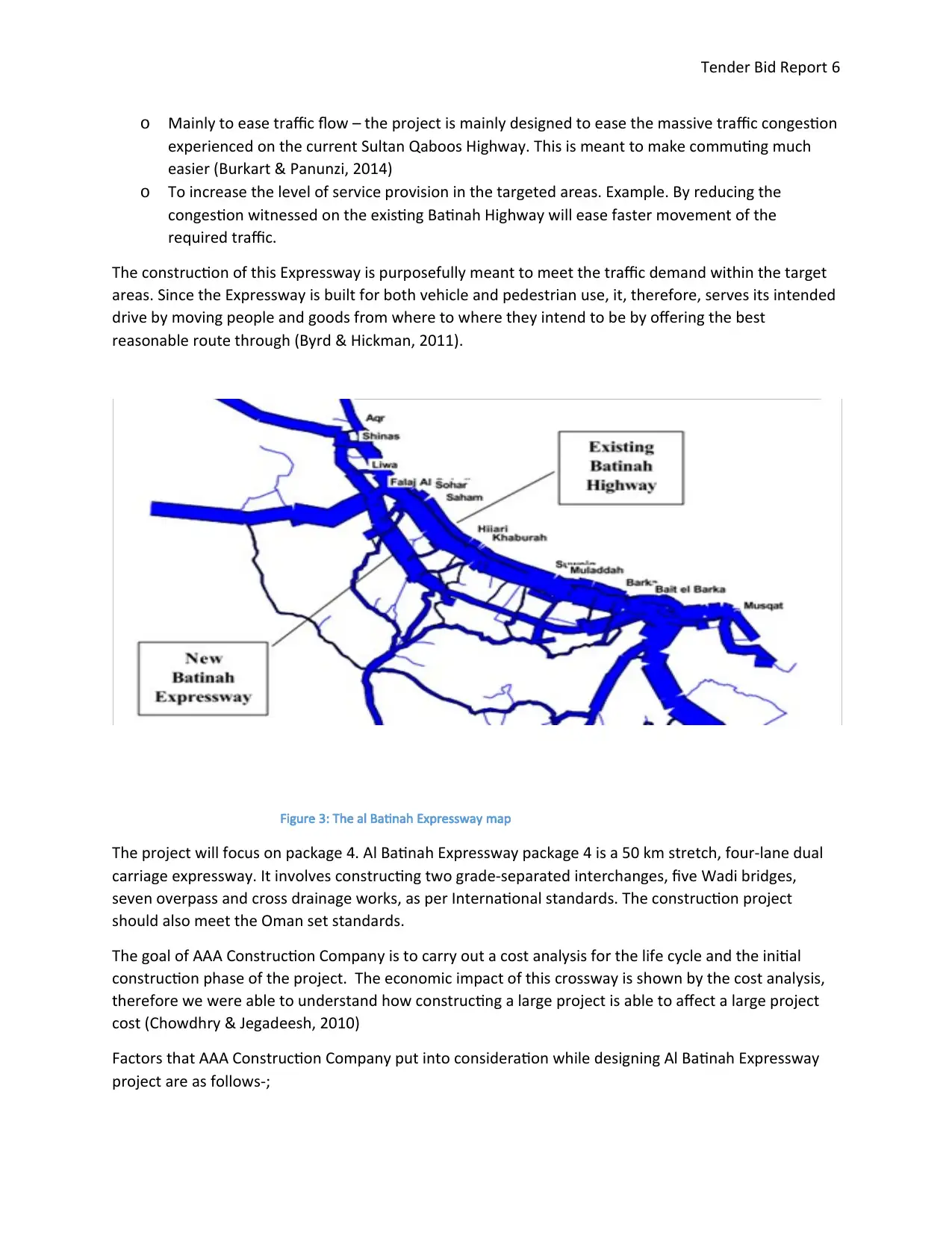
Tender Bid Report 6
o Mainly to ease traffic flow – the project is mainly designed to ease the massive traffic congestion
experienced on the current Sultan Qaboos Highway. This is meant to make commuting much
easier (Burkart & Panunzi, 2014)
o To increase the level of service provision in the targeted areas. Example. By reducing the
congestion witnessed on the existing Batinah Highway will ease faster movement of the
required traffic.
The construction of this Expressway is purposefully meant to meet the traffic demand within the target
areas. Since the Expressway is built for both vehicle and pedestrian use, it, therefore, serves its intended
drive by moving people and goods from where to where they intend to be by offering the best
reasonable route through (Byrd & Hickman, 2011).
Figure 3: The al Batinah Expressway map
The project will focus on package 4. Al Batinah Expressway package 4 is a 50 km stretch, four-lane dual
carriage expressway. It involves constructing two grade-separated interchanges, five Wadi bridges,
seven overpass and cross drainage works, as per International standards. The construction project
should also meet the Oman set standards.
The goal of AAA Construction Company is to carry out a cost analysis for the life cycle and the initial
construction phase of the project. The economic impact of this crossway is shown by the cost analysis,
therefore we were able to understand how constructing a large project is able to affect a large project
cost (Chowdhry & Jegadeesh, 2010)
Factors that AAA Construction Company put into consideration while designing Al Batinah Expressway
project are as follows-;
o Mainly to ease traffic flow – the project is mainly designed to ease the massive traffic congestion
experienced on the current Sultan Qaboos Highway. This is meant to make commuting much
easier (Burkart & Panunzi, 2014)
o To increase the level of service provision in the targeted areas. Example. By reducing the
congestion witnessed on the existing Batinah Highway will ease faster movement of the
required traffic.
The construction of this Expressway is purposefully meant to meet the traffic demand within the target
areas. Since the Expressway is built for both vehicle and pedestrian use, it, therefore, serves its intended
drive by moving people and goods from where to where they intend to be by offering the best
reasonable route through (Byrd & Hickman, 2011).
Figure 3: The al Batinah Expressway map
The project will focus on package 4. Al Batinah Expressway package 4 is a 50 km stretch, four-lane dual
carriage expressway. It involves constructing two grade-separated interchanges, five Wadi bridges,
seven overpass and cross drainage works, as per International standards. The construction project
should also meet the Oman set standards.
The goal of AAA Construction Company is to carry out a cost analysis for the life cycle and the initial
construction phase of the project. The economic impact of this crossway is shown by the cost analysis,
therefore we were able to understand how constructing a large project is able to affect a large project
cost (Chowdhry & Jegadeesh, 2010)
Factors that AAA Construction Company put into consideration while designing Al Batinah Expressway
project are as follows-;
⊘ This is a preview!⊘
Do you want full access?
Subscribe today to unlock all pages.

Trusted by 1+ million students worldwide
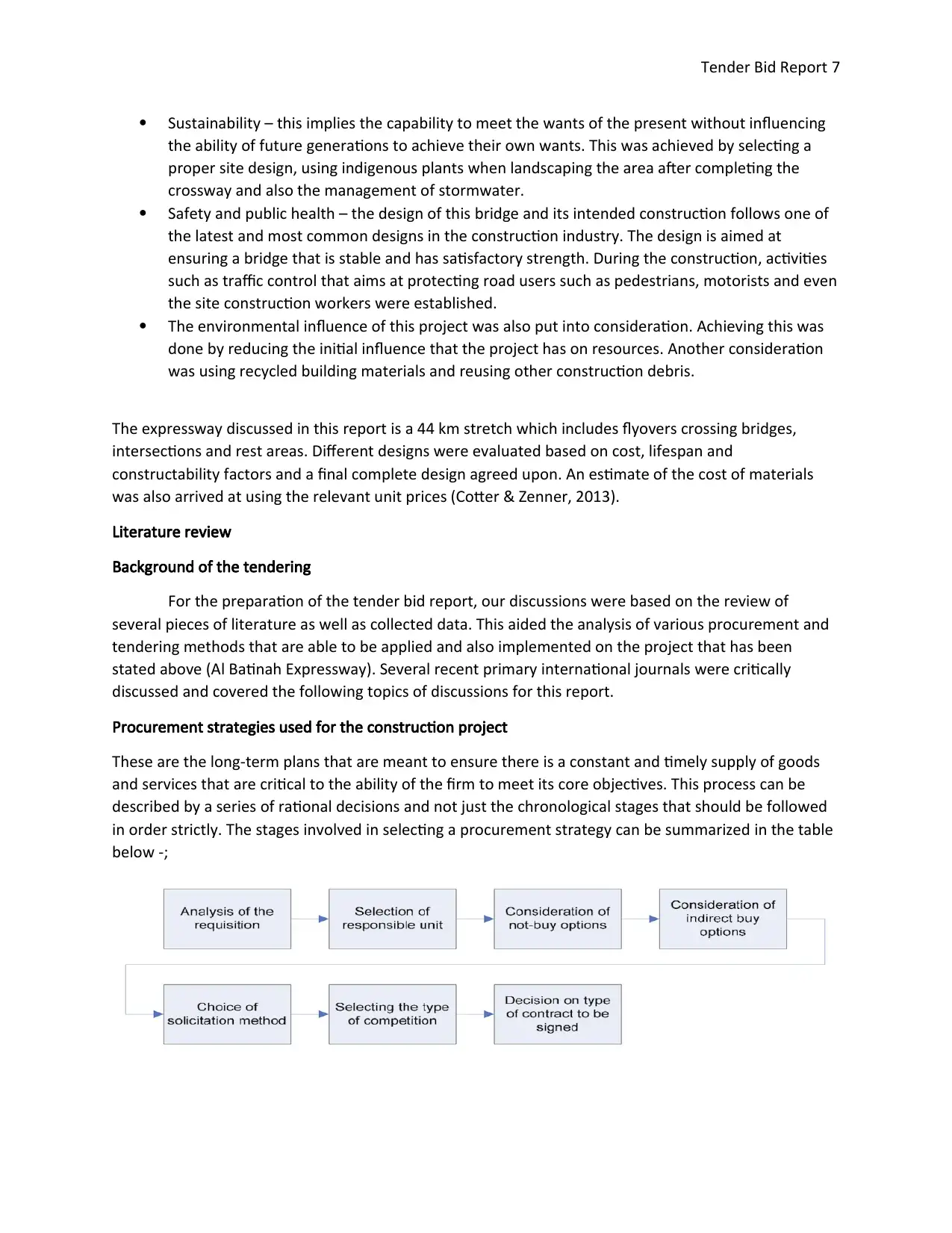
Tender Bid Report 7
Sustainability – this implies the capability to meet the wants of the present without influencing
the ability of future generations to achieve their own wants. This was achieved by selecting a
proper site design, using indigenous plants when landscaping the area after completing the
crossway and also the management of stormwater.
Safety and public health – the design of this bridge and its intended construction follows one of
the latest and most common designs in the construction industry. The design is aimed at
ensuring a bridge that is stable and has satisfactory strength. During the construction, activities
such as traffic control that aims at protecting road users such as pedestrians, motorists and even
the site construction workers were established.
The environmental influence of this project was also put into consideration. Achieving this was
done by reducing the initial influence that the project has on resources. Another consideration
was using recycled building materials and reusing other construction debris.
The expressway discussed in this report is a 44 km stretch which includes flyovers crossing bridges,
intersections and rest areas. Different designs were evaluated based on cost, lifespan and
constructability factors and a final complete design agreed upon. An estimate of the cost of materials
was also arrived at using the relevant unit prices (Cotter & Zenner, 2013).
Literature review
Background of the tendering
For the preparation of the tender bid report, our discussions were based on the review of
several pieces of literature as well as collected data. This aided the analysis of various procurement and
tendering methods that are able to be applied and also implemented on the project that has been
stated above (Al Batinah Expressway). Several recent primary international journals were critically
discussed and covered the following topics of discussions for this report.
Procurement strategies used for the construction project
These are the long-term plans that are meant to ensure there is a constant and timely supply of goods
and services that are critical to the ability of the firm to meet its core objectives. This process can be
described by a series of rational decisions and not just the chronological stages that should be followed
in order strictly. The stages involved in selecting a procurement strategy can be summarized in the table
below -;
Sustainability – this implies the capability to meet the wants of the present without influencing
the ability of future generations to achieve their own wants. This was achieved by selecting a
proper site design, using indigenous plants when landscaping the area after completing the
crossway and also the management of stormwater.
Safety and public health – the design of this bridge and its intended construction follows one of
the latest and most common designs in the construction industry. The design is aimed at
ensuring a bridge that is stable and has satisfactory strength. During the construction, activities
such as traffic control that aims at protecting road users such as pedestrians, motorists and even
the site construction workers were established.
The environmental influence of this project was also put into consideration. Achieving this was
done by reducing the initial influence that the project has on resources. Another consideration
was using recycled building materials and reusing other construction debris.
The expressway discussed in this report is a 44 km stretch which includes flyovers crossing bridges,
intersections and rest areas. Different designs were evaluated based on cost, lifespan and
constructability factors and a final complete design agreed upon. An estimate of the cost of materials
was also arrived at using the relevant unit prices (Cotter & Zenner, 2013).
Literature review
Background of the tendering
For the preparation of the tender bid report, our discussions were based on the review of
several pieces of literature as well as collected data. This aided the analysis of various procurement and
tendering methods that are able to be applied and also implemented on the project that has been
stated above (Al Batinah Expressway). Several recent primary international journals were critically
discussed and covered the following topics of discussions for this report.
Procurement strategies used for the construction project
These are the long-term plans that are meant to ensure there is a constant and timely supply of goods
and services that are critical to the ability of the firm to meet its core objectives. This process can be
described by a series of rational decisions and not just the chronological stages that should be followed
in order strictly. The stages involved in selecting a procurement strategy can be summarized in the table
below -;
Paraphrase This Document
Need a fresh take? Get an instant paraphrase of this document with our AI Paraphraser
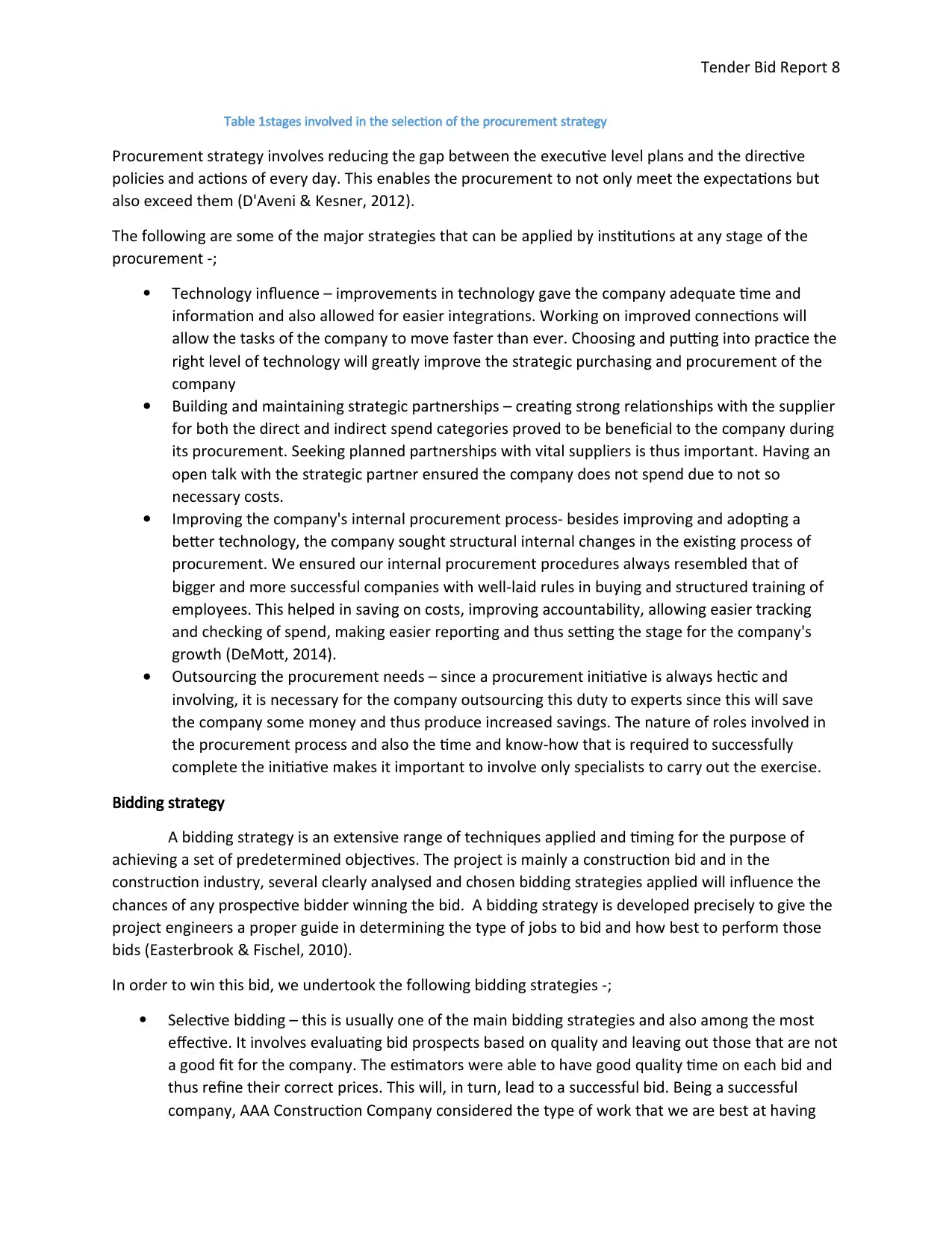
Tender Bid Report 8
Table 1stages involved in the selection of the procurement strategy
Procurement strategy involves reducing the gap between the executive level plans and the directive
policies and actions of every day. This enables the procurement to not only meet the expectations but
also exceed them (D'Aveni & Kesner, 2012).
The following are some of the major strategies that can be applied by institutions at any stage of the
procurement -;
Technology influence – improvements in technology gave the company adequate time and
information and also allowed for easier integrations. Working on improved connections will
allow the tasks of the company to move faster than ever. Choosing and putting into practice the
right level of technology will greatly improve the strategic purchasing and procurement of the
company
Building and maintaining strategic partnerships – creating strong relationships with the supplier
for both the direct and indirect spend categories proved to be beneficial to the company during
its procurement. Seeking planned partnerships with vital suppliers is thus important. Having an
open talk with the strategic partner ensured the company does not spend due to not so
necessary costs.
Improving the company's internal procurement process- besides improving and adopting a
better technology, the company sought structural internal changes in the existing process of
procurement. We ensured our internal procurement procedures always resembled that of
bigger and more successful companies with well-laid rules in buying and structured training of
employees. This helped in saving on costs, improving accountability, allowing easier tracking
and checking of spend, making easier reporting and thus setting the stage for the company's
growth (DeMott, 2014).
Outsourcing the procurement needs – since a procurement initiative is always hectic and
involving, it is necessary for the company outsourcing this duty to experts since this will save
the company some money and thus produce increased savings. The nature of roles involved in
the procurement process and also the time and know-how that is required to successfully
complete the initiative makes it important to involve only specialists to carry out the exercise.
Bidding strategy
A bidding strategy is an extensive range of techniques applied and timing for the purpose of
achieving a set of predetermined objectives. The project is mainly a construction bid and in the
construction industry, several clearly analysed and chosen bidding strategies applied will influence the
chances of any prospective bidder winning the bid. A bidding strategy is developed precisely to give the
project engineers a proper guide in determining the type of jobs to bid and how best to perform those
bids (Easterbrook & Fischel, 2010).
In order to win this bid, we undertook the following bidding strategies -;
Selective bidding – this is usually one of the main bidding strategies and also among the most
effective. It involves evaluating bid prospects based on quality and leaving out those that are not
a good fit for the company. The estimators were able to have good quality time on each bid and
thus refine their correct prices. This will, in turn, lead to a successful bid. Being a successful
company, AAA Construction Company considered the type of work that we are best at having
Table 1stages involved in the selection of the procurement strategy
Procurement strategy involves reducing the gap between the executive level plans and the directive
policies and actions of every day. This enables the procurement to not only meet the expectations but
also exceed them (D'Aveni & Kesner, 2012).
The following are some of the major strategies that can be applied by institutions at any stage of the
procurement -;
Technology influence – improvements in technology gave the company adequate time and
information and also allowed for easier integrations. Working on improved connections will
allow the tasks of the company to move faster than ever. Choosing and putting into practice the
right level of technology will greatly improve the strategic purchasing and procurement of the
company
Building and maintaining strategic partnerships – creating strong relationships with the supplier
for both the direct and indirect spend categories proved to be beneficial to the company during
its procurement. Seeking planned partnerships with vital suppliers is thus important. Having an
open talk with the strategic partner ensured the company does not spend due to not so
necessary costs.
Improving the company's internal procurement process- besides improving and adopting a
better technology, the company sought structural internal changes in the existing process of
procurement. We ensured our internal procurement procedures always resembled that of
bigger and more successful companies with well-laid rules in buying and structured training of
employees. This helped in saving on costs, improving accountability, allowing easier tracking
and checking of spend, making easier reporting and thus setting the stage for the company's
growth (DeMott, 2014).
Outsourcing the procurement needs – since a procurement initiative is always hectic and
involving, it is necessary for the company outsourcing this duty to experts since this will save
the company some money and thus produce increased savings. The nature of roles involved in
the procurement process and also the time and know-how that is required to successfully
complete the initiative makes it important to involve only specialists to carry out the exercise.
Bidding strategy
A bidding strategy is an extensive range of techniques applied and timing for the purpose of
achieving a set of predetermined objectives. The project is mainly a construction bid and in the
construction industry, several clearly analysed and chosen bidding strategies applied will influence the
chances of any prospective bidder winning the bid. A bidding strategy is developed precisely to give the
project engineers a proper guide in determining the type of jobs to bid and how best to perform those
bids (Easterbrook & Fischel, 2010).
In order to win this bid, we undertook the following bidding strategies -;
Selective bidding – this is usually one of the main bidding strategies and also among the most
effective. It involves evaluating bid prospects based on quality and leaving out those that are not
a good fit for the company. The estimators were able to have good quality time on each bid and
thus refine their correct prices. This will, in turn, lead to a successful bid. Being a successful
company, AAA Construction Company considered the type of work that we are best at having
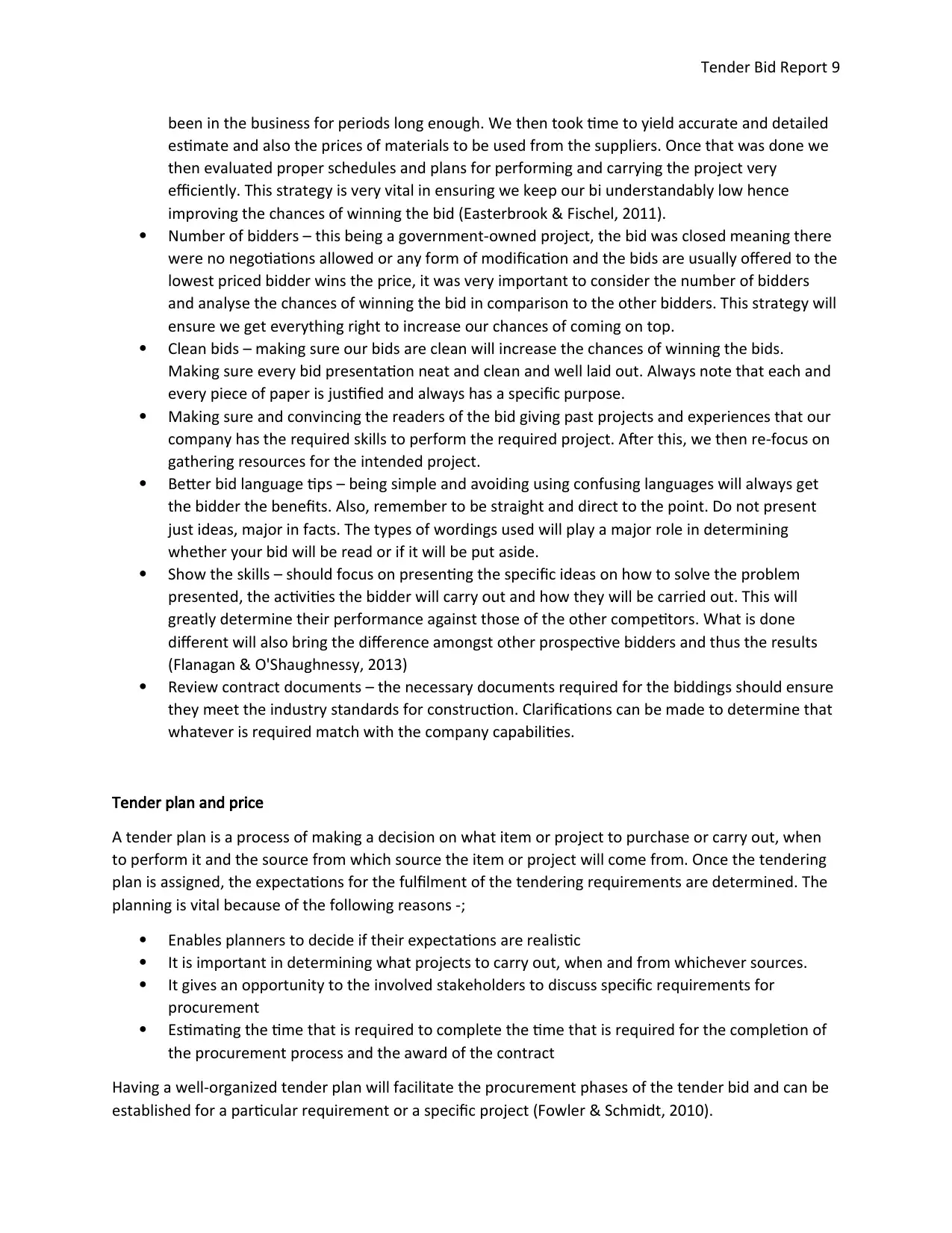
Tender Bid Report 9
been in the business for periods long enough. We then took time to yield accurate and detailed
estimate and also the prices of materials to be used from the suppliers. Once that was done we
then evaluated proper schedules and plans for performing and carrying the project very
efficiently. This strategy is very vital in ensuring we keep our bi understandably low hence
improving the chances of winning the bid (Easterbrook & Fischel, 2011).
Number of bidders – this being a government-owned project, the bid was closed meaning there
were no negotiations allowed or any form of modification and the bids are usually offered to the
lowest priced bidder wins the price, it was very important to consider the number of bidders
and analyse the chances of winning the bid in comparison to the other bidders. This strategy will
ensure we get everything right to increase our chances of coming on top.
Clean bids – making sure our bids are clean will increase the chances of winning the bids.
Making sure every bid presentation neat and clean and well laid out. Always note that each and
every piece of paper is justified and always has a specific purpose.
Making sure and convincing the readers of the bid giving past projects and experiences that our
company has the required skills to perform the required project. After this, we then re-focus on
gathering resources for the intended project.
Better bid language tips – being simple and avoiding using confusing languages will always get
the bidder the benefits. Also, remember to be straight and direct to the point. Do not present
just ideas, major in facts. The types of wordings used will play a major role in determining
whether your bid will be read or if it will be put aside.
Show the skills – should focus on presenting the specific ideas on how to solve the problem
presented, the activities the bidder will carry out and how they will be carried out. This will
greatly determine their performance against those of the other competitors. What is done
different will also bring the difference amongst other prospective bidders and thus the results
(Flanagan & O'Shaughnessy, 2013)
Review contract documents – the necessary documents required for the biddings should ensure
they meet the industry standards for construction. Clarifications can be made to determine that
whatever is required match with the company capabilities.
Tender plan and price
A tender plan is a process of making a decision on what item or project to purchase or carry out, when
to perform it and the source from which source the item or project will come from. Once the tendering
plan is assigned, the expectations for the fulfilment of the tendering requirements are determined. The
planning is vital because of the following reasons -;
Enables planners to decide if their expectations are realistic
It is important in determining what projects to carry out, when and from whichever sources.
It gives an opportunity to the involved stakeholders to discuss specific requirements for
procurement
Estimating the time that is required to complete the time that is required for the completion of
the procurement process and the award of the contract
Having a well-organized tender plan will facilitate the procurement phases of the tender bid and can be
established for a particular requirement or a specific project (Fowler & Schmidt, 2010).
been in the business for periods long enough. We then took time to yield accurate and detailed
estimate and also the prices of materials to be used from the suppliers. Once that was done we
then evaluated proper schedules and plans for performing and carrying the project very
efficiently. This strategy is very vital in ensuring we keep our bi understandably low hence
improving the chances of winning the bid (Easterbrook & Fischel, 2011).
Number of bidders – this being a government-owned project, the bid was closed meaning there
were no negotiations allowed or any form of modification and the bids are usually offered to the
lowest priced bidder wins the price, it was very important to consider the number of bidders
and analyse the chances of winning the bid in comparison to the other bidders. This strategy will
ensure we get everything right to increase our chances of coming on top.
Clean bids – making sure our bids are clean will increase the chances of winning the bids.
Making sure every bid presentation neat and clean and well laid out. Always note that each and
every piece of paper is justified and always has a specific purpose.
Making sure and convincing the readers of the bid giving past projects and experiences that our
company has the required skills to perform the required project. After this, we then re-focus on
gathering resources for the intended project.
Better bid language tips – being simple and avoiding using confusing languages will always get
the bidder the benefits. Also, remember to be straight and direct to the point. Do not present
just ideas, major in facts. The types of wordings used will play a major role in determining
whether your bid will be read or if it will be put aside.
Show the skills – should focus on presenting the specific ideas on how to solve the problem
presented, the activities the bidder will carry out and how they will be carried out. This will
greatly determine their performance against those of the other competitors. What is done
different will also bring the difference amongst other prospective bidders and thus the results
(Flanagan & O'Shaughnessy, 2013)
Review contract documents – the necessary documents required for the biddings should ensure
they meet the industry standards for construction. Clarifications can be made to determine that
whatever is required match with the company capabilities.
Tender plan and price
A tender plan is a process of making a decision on what item or project to purchase or carry out, when
to perform it and the source from which source the item or project will come from. Once the tendering
plan is assigned, the expectations for the fulfilment of the tendering requirements are determined. The
planning is vital because of the following reasons -;
Enables planners to decide if their expectations are realistic
It is important in determining what projects to carry out, when and from whichever sources.
It gives an opportunity to the involved stakeholders to discuss specific requirements for
procurement
Estimating the time that is required to complete the time that is required for the completion of
the procurement process and the award of the contract
Having a well-organized tender plan will facilitate the procurement phases of the tender bid and can be
established for a particular requirement or a specific project (Fowler & Schmidt, 2010).
⊘ This is a preview!⊘
Do you want full access?
Subscribe today to unlock all pages.

Trusted by 1+ million students worldwide
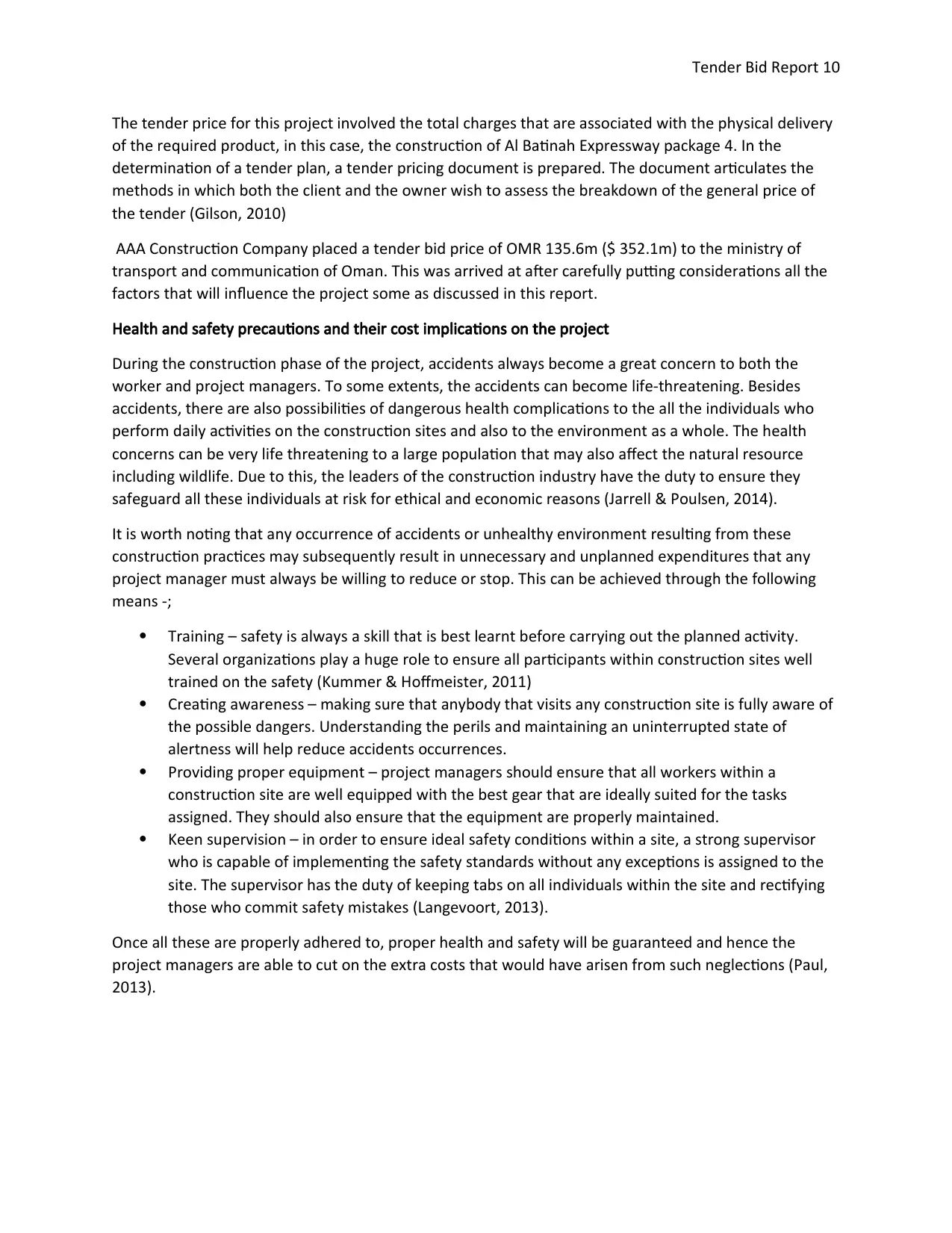
Tender Bid Report 10
The tender price for this project involved the total charges that are associated with the physical delivery
of the required product, in this case, the construction of Al Batinah Expressway package 4. In the
determination of a tender plan, a tender pricing document is prepared. The document articulates the
methods in which both the client and the owner wish to assess the breakdown of the general price of
the tender (Gilson, 2010)
AAA Construction Company placed a tender bid price of OMR 135.6m ($ 352.1m) to the ministry of
transport and communication of Oman. This was arrived at after carefully putting considerations all the
factors that will influence the project some as discussed in this report.
Health and safety precautions and their cost implications on the project
During the construction phase of the project, accidents always become a great concern to both the
worker and project managers. To some extents, the accidents can become life-threatening. Besides
accidents, there are also possibilities of dangerous health complications to the all the individuals who
perform daily activities on the construction sites and also to the environment as a whole. The health
concerns can be very life threatening to a large population that may also affect the natural resource
including wildlife. Due to this, the leaders of the construction industry have the duty to ensure they
safeguard all these individuals at risk for ethical and economic reasons (Jarrell & Poulsen, 2014).
It is worth noting that any occurrence of accidents or unhealthy environment resulting from these
construction practices may subsequently result in unnecessary and unplanned expenditures that any
project manager must always be willing to reduce or stop. This can be achieved through the following
means -;
Training – safety is always a skill that is best learnt before carrying out the planned activity.
Several organizations play a huge role to ensure all participants within construction sites well
trained on the safety (Kummer & Hoffmeister, 2011)
Creating awareness – making sure that anybody that visits any construction site is fully aware of
the possible dangers. Understanding the perils and maintaining an uninterrupted state of
alertness will help reduce accidents occurrences.
Providing proper equipment – project managers should ensure that all workers within a
construction site are well equipped with the best gear that are ideally suited for the tasks
assigned. They should also ensure that the equipment are properly maintained.
Keen supervision – in order to ensure ideal safety conditions within a site, a strong supervisor
who is capable of implementing the safety standards without any exceptions is assigned to the
site. The supervisor has the duty of keeping tabs on all individuals within the site and rectifying
those who commit safety mistakes (Langevoort, 2013).
Once all these are properly adhered to, proper health and safety will be guaranteed and hence the
project managers are able to cut on the extra costs that would have arisen from such neglections (Paul,
2013).
The tender price for this project involved the total charges that are associated with the physical delivery
of the required product, in this case, the construction of Al Batinah Expressway package 4. In the
determination of a tender plan, a tender pricing document is prepared. The document articulates the
methods in which both the client and the owner wish to assess the breakdown of the general price of
the tender (Gilson, 2010)
AAA Construction Company placed a tender bid price of OMR 135.6m ($ 352.1m) to the ministry of
transport and communication of Oman. This was arrived at after carefully putting considerations all the
factors that will influence the project some as discussed in this report.
Health and safety precautions and their cost implications on the project
During the construction phase of the project, accidents always become a great concern to both the
worker and project managers. To some extents, the accidents can become life-threatening. Besides
accidents, there are also possibilities of dangerous health complications to the all the individuals who
perform daily activities on the construction sites and also to the environment as a whole. The health
concerns can be very life threatening to a large population that may also affect the natural resource
including wildlife. Due to this, the leaders of the construction industry have the duty to ensure they
safeguard all these individuals at risk for ethical and economic reasons (Jarrell & Poulsen, 2014).
It is worth noting that any occurrence of accidents or unhealthy environment resulting from these
construction practices may subsequently result in unnecessary and unplanned expenditures that any
project manager must always be willing to reduce or stop. This can be achieved through the following
means -;
Training – safety is always a skill that is best learnt before carrying out the planned activity.
Several organizations play a huge role to ensure all participants within construction sites well
trained on the safety (Kummer & Hoffmeister, 2011)
Creating awareness – making sure that anybody that visits any construction site is fully aware of
the possible dangers. Understanding the perils and maintaining an uninterrupted state of
alertness will help reduce accidents occurrences.
Providing proper equipment – project managers should ensure that all workers within a
construction site are well equipped with the best gear that are ideally suited for the tasks
assigned. They should also ensure that the equipment are properly maintained.
Keen supervision – in order to ensure ideal safety conditions within a site, a strong supervisor
who is capable of implementing the safety standards without any exceptions is assigned to the
site. The supervisor has the duty of keeping tabs on all individuals within the site and rectifying
those who commit safety mistakes (Langevoort, 2013).
Once all these are properly adhered to, proper health and safety will be guaranteed and hence the
project managers are able to cut on the extra costs that would have arisen from such neglections (Paul,
2013).
Paraphrase This Document
Need a fresh take? Get an instant paraphrase of this document with our AI Paraphraser
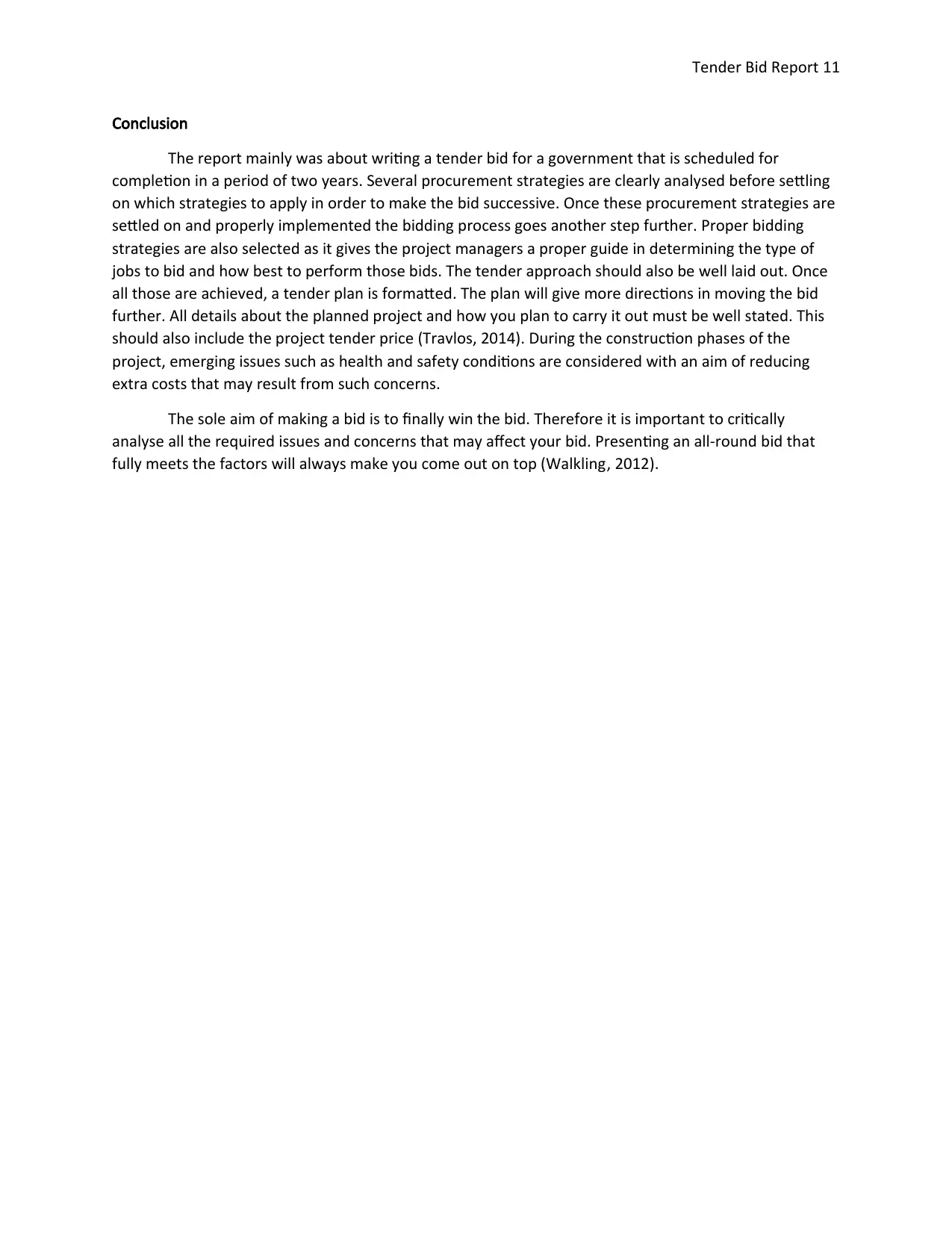
Tender Bid Report 11
Conclusion
The report mainly was about writing a tender bid for a government that is scheduled for
completion in a period of two years. Several procurement strategies are clearly analysed before settling
on which strategies to apply in order to make the bid successive. Once these procurement strategies are
settled on and properly implemented the bidding process goes another step further. Proper bidding
strategies are also selected as it gives the project managers a proper guide in determining the type of
jobs to bid and how best to perform those bids. The tender approach should also be well laid out. Once
all those are achieved, a tender plan is formatted. The plan will give more directions in moving the bid
further. All details about the planned project and how you plan to carry it out must be well stated. This
should also include the project tender price (Travlos, 2014). During the construction phases of the
project, emerging issues such as health and safety conditions are considered with an aim of reducing
extra costs that may result from such concerns.
The sole aim of making a bid is to finally win the bid. Therefore it is important to critically
analyse all the required issues and concerns that may affect your bid. Presenting an all-round bid that
fully meets the factors will always make you come out on top (Walkling, 2012).
Conclusion
The report mainly was about writing a tender bid for a government that is scheduled for
completion in a period of two years. Several procurement strategies are clearly analysed before settling
on which strategies to apply in order to make the bid successive. Once these procurement strategies are
settled on and properly implemented the bidding process goes another step further. Proper bidding
strategies are also selected as it gives the project managers a proper guide in determining the type of
jobs to bid and how best to perform those bids. The tender approach should also be well laid out. Once
all those are achieved, a tender plan is formatted. The plan will give more directions in moving the bid
further. All details about the planned project and how you plan to carry it out must be well stated. This
should also include the project tender price (Travlos, 2014). During the construction phases of the
project, emerging issues such as health and safety conditions are considered with an aim of reducing
extra costs that may result from such concerns.
The sole aim of making a bid is to finally win the bid. Therefore it is important to critically
analyse all the required issues and concerns that may affect your bid. Presenting an all-round bid that
fully meets the factors will always make you come out on top (Walkling, 2012).
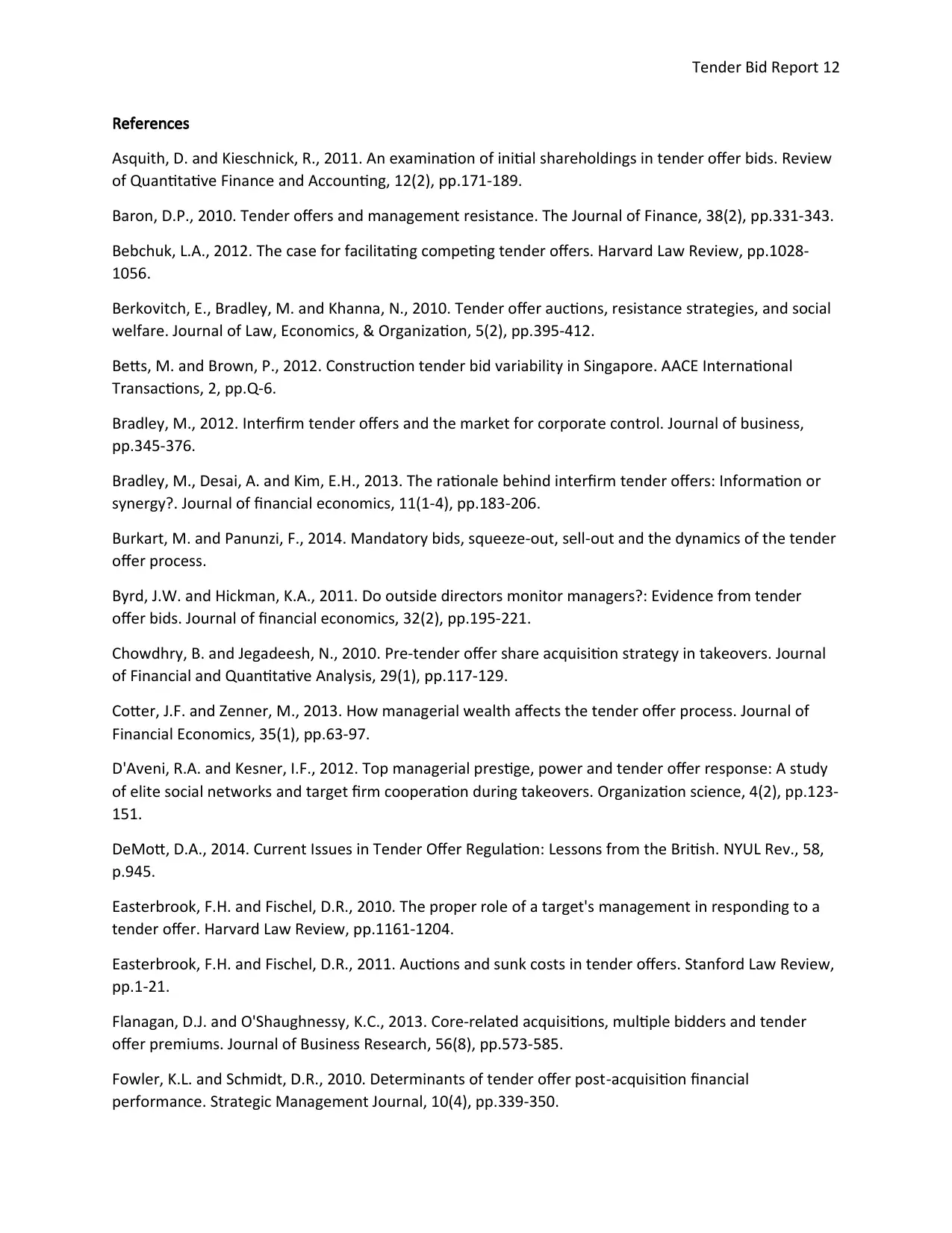
Tender Bid Report 12
References
Asquith, D. and Kieschnick, R., 2011. An examination of initial shareholdings in tender offer bids. Review
of Quantitative Finance and Accounting, 12(2), pp.171-189.
Baron, D.P., 2010. Tender offers and management resistance. The Journal of Finance, 38(2), pp.331-343.
Bebchuk, L.A., 2012. The case for facilitating competing tender offers. Harvard Law Review, pp.1028-
1056.
Berkovitch, E., Bradley, M. and Khanna, N., 2010. Tender offer auctions, resistance strategies, and social
welfare. Journal of Law, Economics, & Organization, 5(2), pp.395-412.
Betts, M. and Brown, P., 2012. Construction tender bid variability in Singapore. AACE International
Transactions, 2, pp.Q-6.
Bradley, M., 2012. Interfirm tender offers and the market for corporate control. Journal of business,
pp.345-376.
Bradley, M., Desai, A. and Kim, E.H., 2013. The rationale behind interfirm tender offers: Information or
synergy?. Journal of financial economics, 11(1-4), pp.183-206.
Burkart, M. and Panunzi, F., 2014. Mandatory bids, squeeze-out, sell-out and the dynamics of the tender
offer process.
Byrd, J.W. and Hickman, K.A., 2011. Do outside directors monitor managers?: Evidence from tender
offer bids. Journal of financial economics, 32(2), pp.195-221.
Chowdhry, B. and Jegadeesh, N., 2010. Pre-tender offer share acquisition strategy in takeovers. Journal
of Financial and Quantitative Analysis, 29(1), pp.117-129.
Cotter, J.F. and Zenner, M., 2013. How managerial wealth affects the tender offer process. Journal of
Financial Economics, 35(1), pp.63-97.
D'Aveni, R.A. and Kesner, I.F., 2012. Top managerial prestige, power and tender offer response: A study
of elite social networks and target firm cooperation during takeovers. Organization science, 4(2), pp.123-
151.
DeMott, D.A., 2014. Current Issues in Tender Offer Regulation: Lessons from the British. NYUL Rev., 58,
p.945.
Easterbrook, F.H. and Fischel, D.R., 2010. The proper role of a target's management in responding to a
tender offer. Harvard Law Review, pp.1161-1204.
Easterbrook, F.H. and Fischel, D.R., 2011. Auctions and sunk costs in tender offers. Stanford Law Review,
pp.1-21.
Flanagan, D.J. and O'Shaughnessy, K.C., 2013. Core-related acquisitions, multiple bidders and tender
offer premiums. Journal of Business Research, 56(8), pp.573-585.
Fowler, K.L. and Schmidt, D.R., 2010. Determinants of tender offer post-acquisition financial
performance. Strategic Management Journal, 10(4), pp.339-350.
References
Asquith, D. and Kieschnick, R., 2011. An examination of initial shareholdings in tender offer bids. Review
of Quantitative Finance and Accounting, 12(2), pp.171-189.
Baron, D.P., 2010. Tender offers and management resistance. The Journal of Finance, 38(2), pp.331-343.
Bebchuk, L.A., 2012. The case for facilitating competing tender offers. Harvard Law Review, pp.1028-
1056.
Berkovitch, E., Bradley, M. and Khanna, N., 2010. Tender offer auctions, resistance strategies, and social
welfare. Journal of Law, Economics, & Organization, 5(2), pp.395-412.
Betts, M. and Brown, P., 2012. Construction tender bid variability in Singapore. AACE International
Transactions, 2, pp.Q-6.
Bradley, M., 2012. Interfirm tender offers and the market for corporate control. Journal of business,
pp.345-376.
Bradley, M., Desai, A. and Kim, E.H., 2013. The rationale behind interfirm tender offers: Information or
synergy?. Journal of financial economics, 11(1-4), pp.183-206.
Burkart, M. and Panunzi, F., 2014. Mandatory bids, squeeze-out, sell-out and the dynamics of the tender
offer process.
Byrd, J.W. and Hickman, K.A., 2011. Do outside directors monitor managers?: Evidence from tender
offer bids. Journal of financial economics, 32(2), pp.195-221.
Chowdhry, B. and Jegadeesh, N., 2010. Pre-tender offer share acquisition strategy in takeovers. Journal
of Financial and Quantitative Analysis, 29(1), pp.117-129.
Cotter, J.F. and Zenner, M., 2013. How managerial wealth affects the tender offer process. Journal of
Financial Economics, 35(1), pp.63-97.
D'Aveni, R.A. and Kesner, I.F., 2012. Top managerial prestige, power and tender offer response: A study
of elite social networks and target firm cooperation during takeovers. Organization science, 4(2), pp.123-
151.
DeMott, D.A., 2014. Current Issues in Tender Offer Regulation: Lessons from the British. NYUL Rev., 58,
p.945.
Easterbrook, F.H. and Fischel, D.R., 2010. The proper role of a target's management in responding to a
tender offer. Harvard Law Review, pp.1161-1204.
Easterbrook, F.H. and Fischel, D.R., 2011. Auctions and sunk costs in tender offers. Stanford Law Review,
pp.1-21.
Flanagan, D.J. and O'Shaughnessy, K.C., 2013. Core-related acquisitions, multiple bidders and tender
offer premiums. Journal of Business Research, 56(8), pp.573-585.
Fowler, K.L. and Schmidt, D.R., 2010. Determinants of tender offer post-acquisition financial
performance. Strategic Management Journal, 10(4), pp.339-350.
⊘ This is a preview!⊘
Do you want full access?
Subscribe today to unlock all pages.

Trusted by 1+ million students worldwide
1 out of 13
Your All-in-One AI-Powered Toolkit for Academic Success.
+13062052269
info@desklib.com
Available 24*7 on WhatsApp / Email
![[object Object]](/_next/static/media/star-bottom.7253800d.svg)
Unlock your academic potential
Copyright © 2020–2025 A2Z Services. All Rights Reserved. Developed and managed by ZUCOL.
